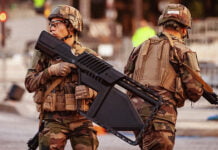 The Australian made and designed autonomous aircraft, MQ-28A Ghost Bat, has achieved a major capability milestone, backed by the government’s $1 billion investment in developing this next generation combat drone. The Ghost Bat is the first military combat aircraft to be designed, engineered and manufactured in Australia in more than 50 years.
The Australian made and designed autonomous aircraft, MQ-28A Ghost Bat, has achieved a major capability milestone, backed by the government’s $1 billion investment in developing this next generation combat drone. The Ghost Bat is the first military combat aircraft to be designed, engineered and manufactured in Australia in more than 50 years.
This latest capability demonstration conducted at Woomera involved a single operator aboard an airborne E-7A Wedgetail taking control of two Ghost Bat aircraft to conduct a mission against an airborne target. The government’s investment in uncrewed and autonomous systems is one of the key priorities outlined in the 2024 National Defence Strategy. The government is investing over $10 billion in drone capabilities including at least $4.3 billion in uncrewed aerial systems.
Developed in cooperation with Boeing Defence Australia, the MQ-28A Ghost Bat is Australia’s first exploration into collaborative combat aircraft technology. Collaborative combat aircraft are uncrewed air vehicles that have the ability to team with crewed platforms performing mission roles and responsibilities typically associated with fighter aircraft. This project supports 350 high-skilled jobs across the nation, including those employed at Boeing Defence Australia and more than 200 Australian suppliers.
Minister for Defence Industry Pat Conroy said: “This is an important step forward in the development of this world-leading, Australian designed and made autonomous aircraft. The Ghost Bat has the potential to turn a single fighter jet into a fighting team, with advanced sensors that are like hundreds of eyes in the sky. Autonomous collaborative platforms enhance the integrated force’s ability to deliver a strategy of denial, by increasing the lethality and survivability with a reduced risk to our forces.”
“This trial demonstrates family-of-systems integration, the strength of our open systems architecture, and is a critical first step towards integrating mission partners’ software and communications systems natively into the E-7A Wedgetail,” said Glen Ferguson, director MQ-28 Global Programs. “It not only validated a key element of the MQ-28 concept of operations, but also how collaborative combat aircraft can expand and enhance the role of the E-7A to meet future force requirements. It is another tangible proof point of the maturity of our program.”
This trial is part of a series of events with RAAF assets throughout this year, collectively known as Capability Demonstration 2025 (CD25). CD25 will demonstrate MQ-28 operational effectiveness and how collaborative combat aircraft will integrate and operate with RAAF crewed assets. Future events will involve teaming with other assets, including F/A-18F and F-35.















This is a very promising platform which I hope the RAAF doesn’t harpoon just to align themselves with the USAAF and their programs. We have a massive amount of country to cover, plus our maritime approaches which is simply not achievable even if we tripled the number of F35s and FA18s we have. Let’s hope that that the cancelation of the fourth squadron of F35s is making way for a substantial buy of Ghost Bats with enhanced Air to Air and Air to Ground capabilities. Who’s afraid of the big black Bat!
I agree – it’s extremely promising technology developed in Australia.
This machine really is the Terminator movie coming to reality.
I honestly think this is one area of development were we are are well ahead. However, the slow small scale approach needs to ramp up right now. This aircraft went from concept to flying in absolute record time. We need to keep that momentum, start ordering block3 now, while we start to field block one immediately. Honestly, we are going to be doing it on our own, one way or another. Yes, we do build 30% of F35 here, but not the rest, so we need this as sovereign capability.
Totally agree
We really haven’t got time to wait for the US. Anduril and General Atomic haven’t even started flight testing of their respective CCAs yet. It is possible to get the MQ-28s in service fairly quickly.
https://thedefensepost.com/2025/06/20/avenger-missile-attack-trial/
Going on this GA’s Avenger is at about the same stage of development as the Ghost Bat
Reported late last week.
“In a major milestone for unmanned combat aviation, US defence contractor General Atomics Aeronautical Systems Inc has successfully demonstrated a simulated autonomous shoot down during a cutting-edge test involving both live and virtual aircraft.
The test, conducted on 11 June, saw General Atomics Aeronautical Systems Inc’s (GA-ASI) MQ-20 Avenger unmanned jet perform a series of autonomous combat functions using advanced government-supplied reference software, complemented by systems developed by US autonomy firm Shield AI.
The MQ-20, operating as an autonomous collaborative aircraft, undertook a range of complex activities, including midair coordination with crewed and uncrewed aircraft, simulated patrol of a contested battlespace, autonomous decision making, and cooperative engagement with a human command element. Crucially, the Avenger autonomously intercepted and simulated a successful missile engagement against two live airborne targets.”
It appears the Avenger is at about the same stage of development as the Ghost Bat
JUST MANUFACTURE HUNDREDS AND THOUSANDS OF THE GHOST BAT TO MAKE IT USEFUL AND HAVE A CHANCE
Taking down an airborne target?
That’s a significant advance for the Ghost Bat.
Seems there is some life in the programme
Advances like this and 1s in the unmanned under-water vessels can only help to maintain our DEFENCES of our country and sorounding allies 👍👍
Col we always punch above our weight and now we have to except that we cannot reliable on past allies so the future now is in our hands and we have always risen to the challenge
Great news and even through this is early days for GB this is the way of the future air for combat capability. More importantly we also need to invest in the brain elements of this capability such as sovereign semi-conductor development, Australia is significantly exposed and reliant on overseas sources in this technology.
I agree – uncrewed systems will dominate operations in the coming decades. The only reason why the US will sell second hand Virginia class submarines to us is because they will be obsolete and will be withdrawn from service in the 2030s.
I hope they collaborate with Ukraine and Israel to get battle hardened, latest tech etc or they will be dead meat in a real battle.
An underwater equivalent drone will be both more difficult to develop and harder to co- ordinate. Stealth as much as intercommunication and multi role as well as being ( relatively) expendable all to ensure surveillance of thousands of km of coast and littoral fields.
Yes and no. Aunduril is developing the Ghost Shark for Australia and it is pushing the idea of using it in combination with other AUVs. Underwater communication is difficult but they propose using acoustic signals for short-range communication. If you can imagine a swarm of these things communicating with each other over short distances and then passing that information downthe line they should be able to co-ordinate with each other on a mission.
Surface communication is a bigger issue but then again that is a problem with crewed submarines as well.